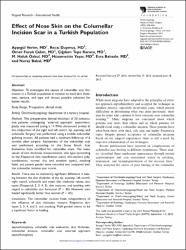| dc.contributor.author | Verim, Ayşegül | |
| dc.contributor.author | Duymuş, Recai | |
| dc.contributor.author | Çalım, Ömer Faruk | |
| dc.contributor.author | Karaca Tepe, Çiğdem | |
| dc.contributor.author | Özkul, Murat Haluk | |
| dc.contributor.author | Yaşar, Hüsamettin | |
| dc.contributor.author | Bahadır, Esra | |
| dc.contributor.author | Bakal, Nuray | |
| dc.date.accessioned | 2020-04-17T06:38:10Z | |
| dc.date.available | 2020-04-17T06:38:10Z | |
| dc.date.issued | 2013 | en_US |
| dc.identifier.citation | Verim, A., Duymuş, R., Çalım, Ö. F., Karaca Tepe, Ç., Özkul, M. H., Yaşar, H. ... Bakal, N. (2013). Effect of nose skin on the columellar incision scar in a Turkish population. Otolaryngology-Head And Neck Surgery, 149(3), 438-444. https://dx.doi.org/10.1177/0194599813496961 | en_US |
| dc.identifier.issn | 0194-5998 | |
| dc.identifier.issn | 1097-6817 | en_US |
| dc.identifier.uri | https://dx.doi.org/10.1177/0194599813496961 | |
| dc.identifier.uri | https://hdl.handle.net/20.500.12511/5137 | |
| dc.description.abstract | Objectives. To investigate the causes of columellar scar formation in a Turkish population in relation to nasal skin thickness, texture, and type and discuss possible solutions for better results. Study Design. Prospective, clinical study. Setting. Otorhinolaryngology department of a tertiary hospital. Methods. The preoperative dermal thickness of 50 consecutive patients undergoing ‘‘external approach’’ septorhinoplasty was measured (using a 14 MHz ultrasound probe) at the midportion of the right and left nostril, tip, supratip, and columella. Surgery was performed using a middle columellar gullwing incision. All patients had a minimum follow-up of 6 months after surgery. Assessment of the columellar scar was performed according to the Stony Brook Scar Evaluation Scale modified for columellar scars. The mean values of skin thickness measurements, skin type (according to the Fitzpatrick skin classification scale), skin texture (oily, combination, normal, dry, and sensitive types), smoking habit, and patient gender were recorded and compared with the columellar incision scar scores. Results. There was no statistically significant difference in healing between the skin thickness of the tip, supratip, left nostril, right nostril, columella and mean skin thickness values, skin types (Fitzpatrick 2, 3, 4, 5), skin textures, and smoking with regard to columellar scar formation (P . .05). However, men healed significantly better than women (P \.05). Conclusions. The columellar incision heals independently of the influence of skin thickness; texture; Fitzpatrick skin types 2, 3, 4, and 5; and smoking. Male gender seems to be a significant factor in healing | en_US |
| dc.language.iso | eng | en_US |
| dc.publisher | SAGE Publications Ltd | en_US |
| dc.rights | info:eu-repo/semantics/openAccess | en_US |
| dc.subject | Septorhinoplasty | en_US |
| dc.subject | Columella | en_US |
| dc.subject | Scar Evaluation | en_US |
| dc.subject | Skin Thickness | en_US |
| dc.subject | Columellar Incision | en_US |
| dc.subject | Columellar Scar | en_US |
| dc.subject | External Approach Septorhinoplasty | en_US |
| dc.title | Effect of nose skin on the columellar incision scar in a Turkish population | en_US |
| dc.type | article | en_US |
| dc.relation.ispartof | Otolaryngology-Head And Neck Surgery | en_US |
| dc.department | İstanbul Medipol Üniversitesi, Tıp Fakültesi, Cerrahi Tıp Bilimleri Bölümü, Kulak Burun Boğaz Hastalıkları Ana Bilim Dalı | en_US |
| dc.identifier.volume | 149 | en_US |
| dc.identifier.issue | 3 | en_US |
| dc.identifier.startpage | 438 | en_US |
| dc.identifier.endpage | 444 | en_US |
| dc.relation.publicationcategory | Makale - Uluslararası Hakemli Dergi - Kurum Öğretim Elemanı | en_US |
| dc.identifier.wosquality | Q1 | en_US |
| dc.identifier.scopusquality | Q1 | en_US |


















